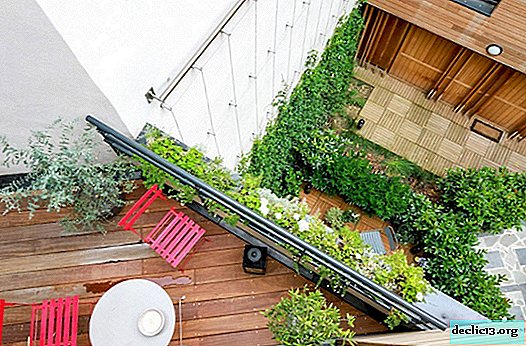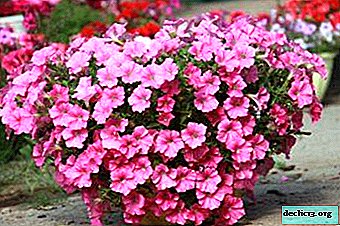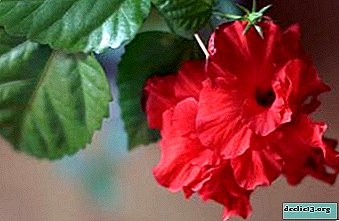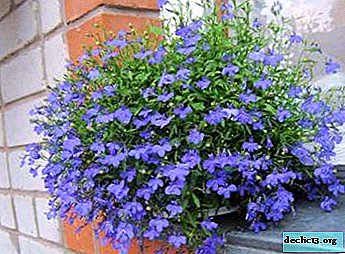Queen of flowers - tea rose. Description and photos of varieties, the nuances of growing at home
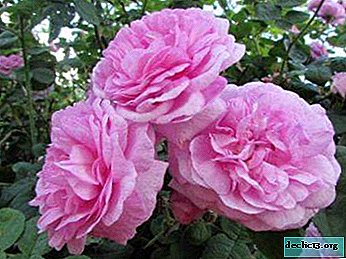
Probably every florist has been growing tea roses at least once in his life. Delicate flowers can decorate any garden plot, and the chemical composition makes it a unique natural medicine for humans. Tea rose, another name is fragrant rose, belongs to the genus of wild rose, the family is pink. According to the modern classification, the varieties founded by Rosa odorata are united in the class of Tea Roses and their clymers. Let's talk about growing a room flower, the nuances of caring for it, show a photo
What it is?
 Description of the botanical characteristics of the plant is as follows:
Description of the botanical characteristics of the plant is as follows:
- Strong, thin stems.
- Elongated neat bud.
- The flowers are large, double. They can be either single or collected in inflorescences (up to 6 pieces).
- Each flower has up to 60 petals and can reach 10 cm in diameter.
The history of tea rose in Europe begins in the 19th century, where it was brought from China by ship with tea. A delicate aroma reminiscent of some varieties of Chinese tea, and gave the name delicate flowers. According to another version, the name of tea roses was given directly by the shape of a flower, reminiscent of a bowl. Among other things, from this variety of plants turns out an unusually tasty drink.
General characteristics of the species
- One of the main distinguishing features of tea rose is its ability to continuously bloom and high-quality flowers.
The intensity of the smell directly depends on the density of the bud and the brightness of the color of the petals.
- The healing properties due to the high content of essential oils, pectin and antibacterial substances.
- Plants are quite thermophilic, most varieties of tea roses do not tolerate frost and are finicky to open ground.
There are also flowers similar to a tea rose. All of them are distinguished by the absence of thorns and large terry flowers resembling a rose bud.
These plants include:
- Ranunculus.
- Chinese rose, hibiscus.
- Eustoma.
- Begonia.
- Some types of geraniums.
- Gardenia.
- Hellebore.
Shrub life span
The lifespan of an individual bush depends on many factors.. The main ones are:
- Features of soil and climate.
- The age of the bush itself.
- The method of propagation of roses.
Proper care of the rose bush will significantly rejuvenate it. The procedure should be carried out in the spring, after removing the covering material.
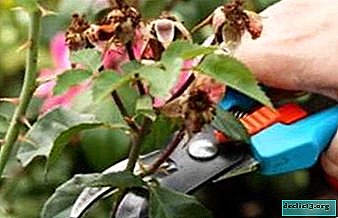 The concept of "rejuvenation" includes cutting a bush, removing excess shoots.
The concept of "rejuvenation" includes cutting a bush, removing excess shoots.- The next stage is an incision of the bark on the root neck of the bush. This will allow the formation of new subordinate roots at the incisions, which will significantly strengthen the existing root system.
- Useful for tea rose bushes to transplant them periodically. Technically, it looks like this - all the stems are cut off at a level of 20 cm from the root neck of the bush, the roots are freed from the ground. In the process, you need to rid the bush of sick and weak shoots. Then fertilizers are applied (it is necessary to fertilize not only the place prepared for planting the bush, but also dip the root system into the solution with fertilizer).
- After these manipulations, the rose is planted in a new place. At the last stage of plant rejuvenation, the necessary number of skeletal shoots must be formed, blind shoots are removed.
Popular types and varieties
At the moment, the varieties of tea roses are the most popular in Russia floribunda, grandiflora, as well as hybrid tea varieties.Floribunda is abundantly blooming roses, they are characterized by almost continuous flowering during the season. The ancestors of the species were tea, polyanthus and nutmeg roses. From tea roses, these shrubs took the form of flowers and a variety of shades, and the polyanthus representatives transmitted immunity and resistance to cold to varieties. The only difference between floribunda and tea hybrid varieties is continuous flowering. For hybrids, wave-like flowering is characteristic.
Grandiflora is a product of crossbreeding, based on varieties of floribunda and tea-hybrid varieties. Flowers of this species are not as lush as those of floribund, but they are not inferior to them in beauty.
What are the colors?
Plants of this species took the best from their ancestors - a variety of colors, size and quality of the flower, helped them to gain a place in the household plots. Tea roses can be as plain; lilac, orange, yellow, white, red, pink, and two-tone. For example, varieties with edging around the edges of the petals are popular. BUT some bushes are even able to change color as the flower blooms!
Photo
In the photo below, you can see how beautiful shrub tea roses grown in room conditions look like.




How to choose a plant when buying?
The type of your garden directly depends on the choice of seedlings. In order not to be disappointed in the purchase, you should follow simple rules.:
- Think about exactly where the rose bush will grow.
- It is better to buy seedlings in specialized nurseries.
- The root system of the seedling should be well developed, have a dark brown color.
- It is worth buying a one-year or two-year-old seedling with several live stems and sleeping buds. Blooming kidneys are a clear reason to refuse a purchase.
- Seedlings in containers are preferable, they are less prone to injury to the root system.
Landing
Method selection
Rose propagation occurs in two ways - seed and vegetative.
Seminal
It is used mainly in the work of breeders to breed new varieties. It differs in its duration, because from planting seeds to the moment the plant blooms, it often takes several years.
Vegetative
 This method includes:
This method includes:
- Cuttings.
- Reproduction by layering.
- Division of the bush.
- Reproduction by vaccination.
The main advantage of vegetative propagation is a guaranteed result.
The resulting plant will have the entire set of characteristics of the mother rose.
Soil preparation
Firstly, the place chosen for planting should be thoroughly cleaned of weed grass. Next you need to dig the soil. The recommended digging depth is 40-50 centimeters. The general rule is that the worse the composition of the soil, the deeper it needs to be dug.
The subtleties of planting roses:
- The stalk must be “recessed” into the ground by at least 5 cm.
- Abundant watering immediately after planting will help the seedling to take root in a new place.
- After absorbing water, the rose should be carefully spudded, for 20-25 cm, create a shadow for a period of at least a week.
- After planting, moisten the soil every 3-5 days.
Pot selection
The main criterion for choosing a pot is the diameter. It should significantly exceed the volume of the roots of the plant. The second important point is the drainage system. If there are no holes in the pot to drain excess water, the plant will quickly rot.
If the holes in the pot are too large, lay a layer of pebble or expanded clay on the bottom.How to care at home?
Conditions of detention
Do not rush to transplant the plant into a new pot, it takes time to get used to the new environment. The optimum temperature for the rose should be no more than 26 degrees. If you exceed this mark - the plant will begin to drop leaves. There is a limitation for the minimum temperature - for a rose it is 15 degrees Celsius. If the temperature drops below the pot - should be brought into the house. The flower is extremely sensitive to remoteness from heating devices.
Watering
 Watering is carried out depending on the season. In summer - twice a day, morning and evening, in winter - based on dry soil. In winter, the flower needs peace.
Watering is carried out depending on the season. In summer - twice a day, morning and evening, in winter - based on dry soil. In winter, the flower needs peace.
It needs to be sprayed periodically, watering is carried out every 5-7 days. Water is also of great importance - rose will not appreciate tap water due to the large number of various impurities.
Use purified or rain water. After 30-40 minutes after watering, excess water from the pan should be drained, otherwise the earth can quickly become acidic.
Top dressing
For roses, the optimal time for fertilizing is in the spring and continues until the beginning of autumn. Mineral and organic fertilizers must be added. They should be alternated among themselves. Fertilize the rose 1 time in 10 days.
In no case should you fertilize the rose immediately after transplantation and in the cold. This can destroy the plant. Any fertilization should occur in the evening.Pruning
Pruning is essential for home roses, contributes to the thickening and abundant flowering of plants. However, basic rules should be followed:
- Use only sharp tools.
- The tool must be decontaminated before use.
- Fresh sections must be treated with protective equipment.
For indoor roses, pruning is carried out as close to the kidneys as possible.without damaging them. The timing of pruning indoor roses is also important - too early or too late procedure will deplete the plant. The optimal time is immediately after a period of rest.
Transfer
Rose transplantation takes place according to the classical scheme - a pot is selected that is slightly larger than the previous one, and the rose moves to the new habitat. The pot should not be too large - this can lead to acidification of the soil.
Bloom
 If the plant is comfortable with humidity and the place where it grows, flowering will be plentiful and furry. But it happens differently - and then flower growers ask themselves, what to do in such a situation?
If the plant is comfortable with humidity and the place where it grows, flowering will be plentiful and furry. But it happens differently - and then flower growers ask themselves, what to do in such a situation?
Here are some guidelines.:
- If the rose does not bloom, transplant it into a new pot.
- Spend a complete pruning of the bush.
- Change the place where the rose stands, it may be worth changing the lighting and air temperature.
- Feeding.
Breeding
The best way to propagate roses is by grafting. It is better to spend it in the summer season. The length of the handle should be 10-15 cm, after cutting? which must immediately be put in water. Keep track of the number of buds on the handle - there must be at least three. Then the container with the cuttings is put in a warm place and left for 3-4 weeks. After the appearance of the roots, they are planted in a special soil.
Diseases and Pests
Most often roses hit:
- Powdery Mildew
- Rust.
- Spider mite.
- Thrips.
- Aphid.
Powdery mildew manifests itself in white plaque on leaves and stems. Appears with a lack of fresh air or excessive soil fertilizer. In order to cure the plant, the affected areas should be removed, the rest should be treated with specialized drugs (foundationazole, cumulus).
Rust also appears due to insufficient care. In this case, it is important to start proper care as soon as possible and remove the affected areas.
The causes of pests on the domestic rose are common to all species - low humidity and high crowding of plants. The treatment takes place according to the same scheme - the plant needs to be washed, increase air humidity and treat the flower with a phytoerm solution.Tea rose - one of the most successful design decisions in the design of the site. And the knowledge gained from our article will help you avoid mistakes in the process of growing it and allow you to grow a strong, healthy plant.

 The concept of "rejuvenation" includes cutting a bush, removing excess shoots.
The concept of "rejuvenation" includes cutting a bush, removing excess shoots.


